 There's no shelter from a storm this bad. 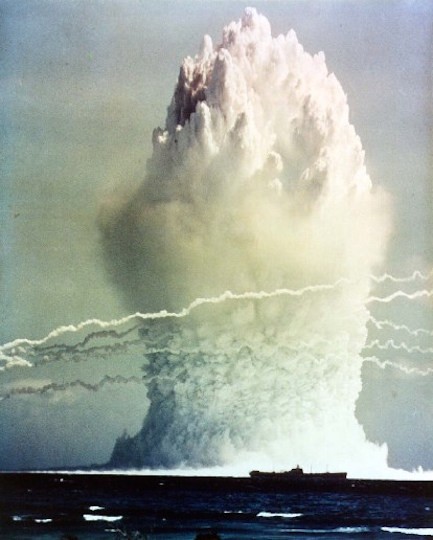
Above is a photo of the underwater nuclear test codenamed Umbrella, which was part of the Hardtack series of tests conducted by the U.S. in the Pacific Proving Grounds—aka Marshall Islands—in the South Pacific. The test happened today in 1958.
 A thorn in the side of the world. 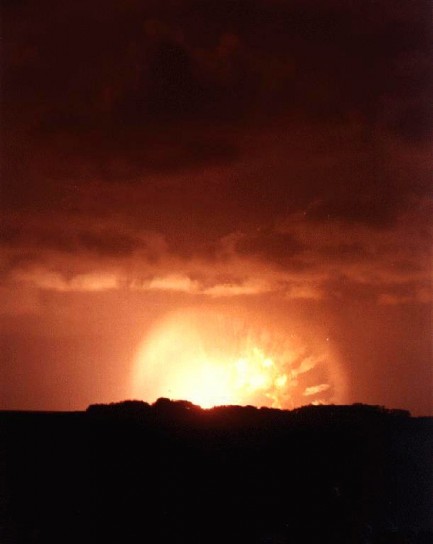
The above photo shows the detonation of the Cactus nuclear device, which was set off today in 1958 on Enewetak Atoll, Marshall Islands, South Pacific, as part of Operation Hardtack I. Yes, there were so many nuclear tests during the ’50s and ’60s that quite a few occurred on the same day in different years. Instead of leaving a house behind Cactus left a crater 346 feet in diameter and forty feet deep. Which these days also could probably be made into an Airbnb.
 This Umbrella doesn't offer much in the way of protection. 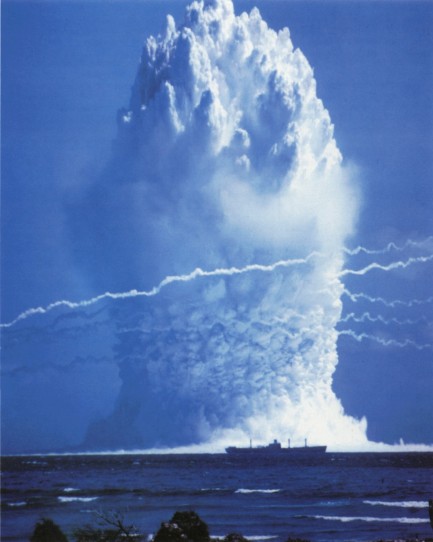
This photo shows the detonation of a U.S. nuclear device codenamed Umbrella, set off on Enewetak Atoll in the Marshall Islands as part of the Hardtack test series, and specifically designed to test radiation contamination on ships exposed to underwater nuclear blasts. The eight kiloton explosion threw a column of water 5,000 feet high, along with whatever unlucky fish, dolphins, and whales happened to be in the vicinity. Just more collateral damage in the ongoing arms race, and certainly not the last. The bomb went off today in 1958.
 Just wait until she shows her face. 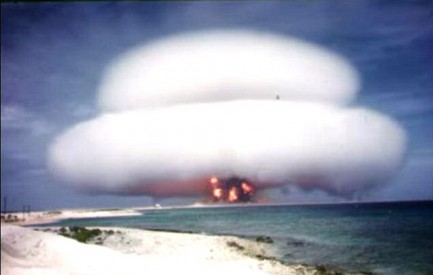 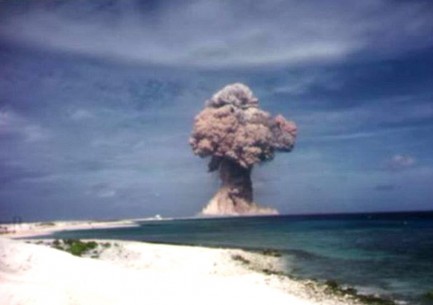
The explosion captured in these two photos is the Nutmeg nuclear test conducted on Eneman Island, part of the Marshall Islands chain, in the South Pacific between Hawaii and the Philippines. The first shows the bomb just after detonation surrounded by what is known as a Wilson Cloud, moisture condensed out of humid air by shock waves. The second photo shows the explosion about fifteen seconds later, with the obscuring moisture burned off. These images were taken from a collection of movies declassified by the U.S. and released by the National Laboratory in March. Everyone seems much more worried about nuclear weapons of late. Well, guess what? It was never a good idea to stop worrying. News outlets always say global warming is the greatest threat to human existence. It isn't. These are. And they will be as long as they exist. The images date from today, 1958
 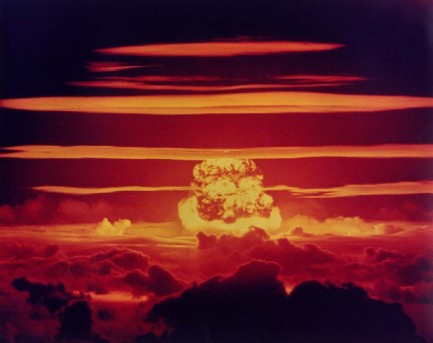
This is one of the more famous images of a nuclear detonation, a shot of the American blast codenamed Dakota, which was part of Operation Redwing, conducted at Bikini Atoll, Marshall Islands, today in 1956. The layered effect you see is sometimes called a Wilson cloud, and consists of water vapor condensed out of the atmosphere by rarefaction, an aftereffect of a shockwave traveling through humid air. In order to perform tests on Bikini Atoll, about 200 Micronesian inhabitants were forced to relocate. They and their descendants hope to return one day, but as of now their home is still too contaminated with radiation.
 Careful now—the footing is truly treacherous. 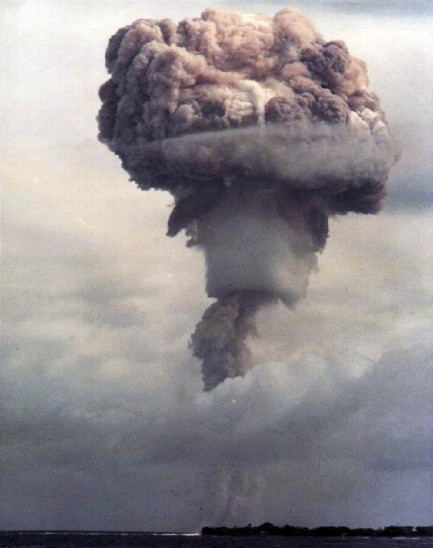 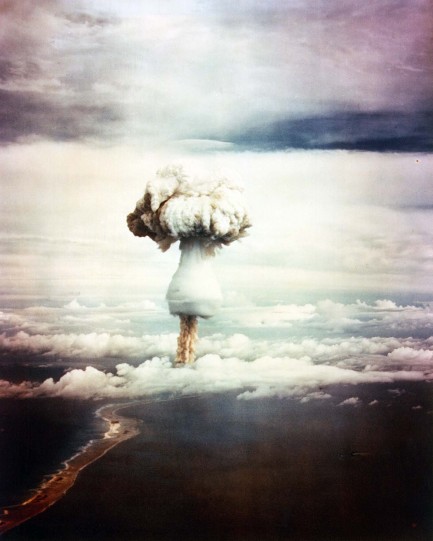
Above, two photos from today in 1955 of a superheated debris cloud over Enewetak Atoll in the Marshall Islands of the South Pacific. It was generated by the nuclear test George, which was part of Operation Greenhouse and was the first test of a boosted fission weapon. What is a boosted fission weapon? Well, it’s more advanced than the world-threatening weapons that came before it, but not as advanced as the world-threatening weapons that came after it. Or put another way, it was a completely redundant step on a ladder to nowhere.
 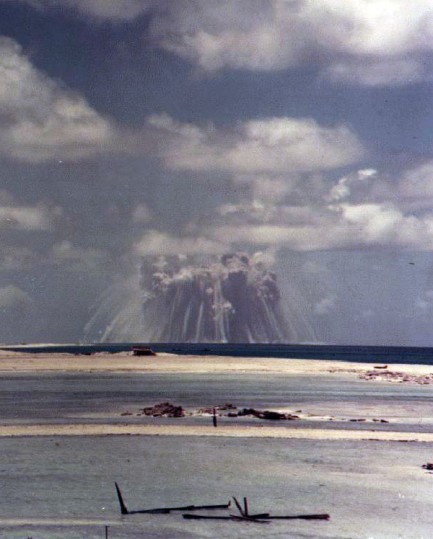
Photo showing the detonation of Seminole B, a 13.7 kiloton nuclear device detonated June 6, 1956 by the U.S. as part of Operation Redwing, a series of nuclear blasts on Eniwetok and Bikini Atolls, Marshall Islands, South Pacific.
 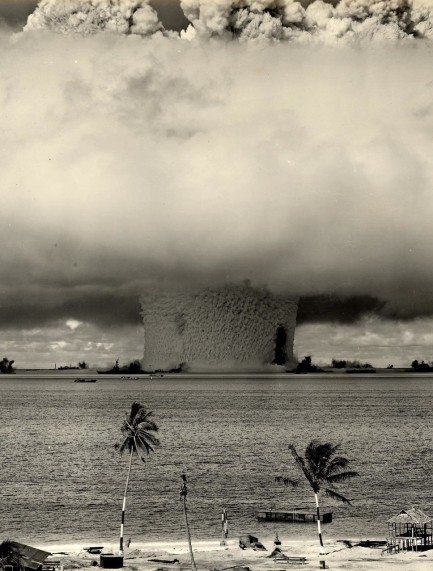
Photo of the American nuclear test Baker, July 23, 1946, part of the series Operation Crossoroads, staged in the Marshall Islands, Micronesia. The test was designed to measure a nuke’s effectiveness on naval vessels (as well as about 400 live pigs and goats aboard the ships). Surprise—it was very effective.
 How to snuff a wild Bikini. 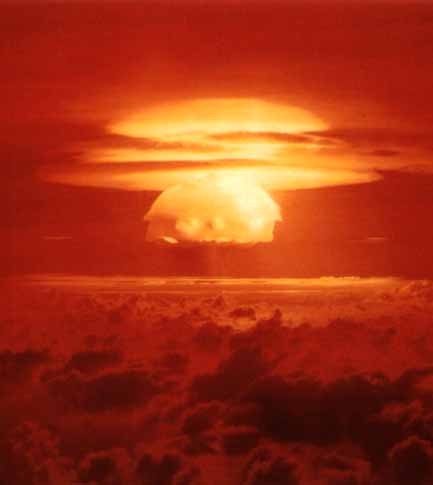
Codenamed Castle Bravo, this is the explosion resulting from the first U.S. test of a dry fuel thermonuclear hydrogen bomb. It happened fifty-five years ago this month, on Bikini Atoll, Marshall Islands, Micronesia.
|
 |

The headlines that mattered yesteryear.
1933—The Gestapo Is Formed
The Geheime Staatspolizei, aka Gestapo, the official secret police force of Nazi Germany, is established. It begins under the administration of SS leader Heinrich Himmler in his position as Chief of German Police, but by 1939 is administered by the Reichssicherheitshauptamt, or Reich Main Security Office, and is a feared entity in every corner of Germany and beyond. 1937—Guernica Is Bombed
In Spain during the Spanish Civil War, the Basque town of Guernica is bombed by the German Luftwaffe, resulting in widespread destruction and casualties. The Basque government reports 1,654 people killed, while later research suggests far fewer deaths, but regardless, Guernica is viewed as an example of terror bombing and other countries learn that Nazi Germany is committed to that tactic. The bombing also becomes inspiration for Pablo Picasso, resulting in a protest painting that is not only his most famous work, but one the most important pieces of art ever produced. 1939—Batman Debuts
In Detective Comics #27, DC Comics publishes its second major superhero, Batman, who becomes one of the most popular comic book characters of all time, and then a popular camp television series starring Adam West, and lastly a multi-million dollar movie franchise starring Michael Keaton, then George Clooney, and finally Christian Bale. 1953—Crick and Watson Publish DNA Results
British scientists James D Watson and Francis Crick publish an article detailing their discovery of the existence and structure of deoxyribonucleic acid, or DNA, in Nature magazine. Their findings answer one of the oldest and most fundamental questions of biology, that of how living things reproduce themselves. 1967—First Space Program Casualty Occurs
Soviet cosmonaut Vladimir Komarov dies in Soyuz 1 when, during re-entry into Earth's atmosphere after more than ten successful orbits, the capsule's main parachute fails to deploy properly, and the backup chute becomes entangled in the first. The capsule's descent is slowed, but it still hits the ground at about 90 mph, at which point it bursts into flames. Komarov is the first human to die during a space mission.
|

|
|

It's easy. We have an uploader that makes it a snap. Use it to submit your art, text, header, and subhead. Your post can be funny, serious, or anything in between, as long as it's vintage pulp. You'll get a byline and experience the fleeting pride of free authorship. We'll edit your post for typos, but the rest is up to you. Click here to give us your best shot.

|
|
























































































